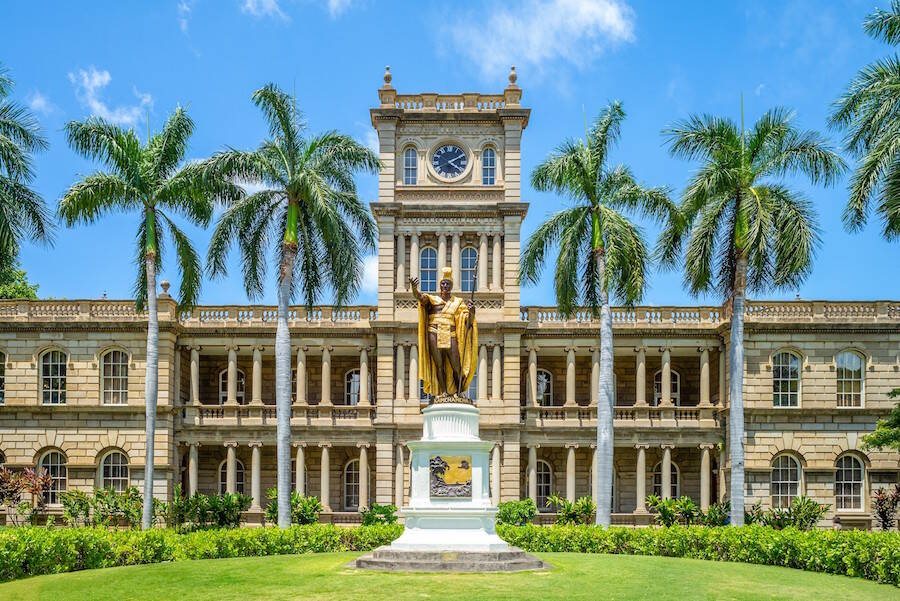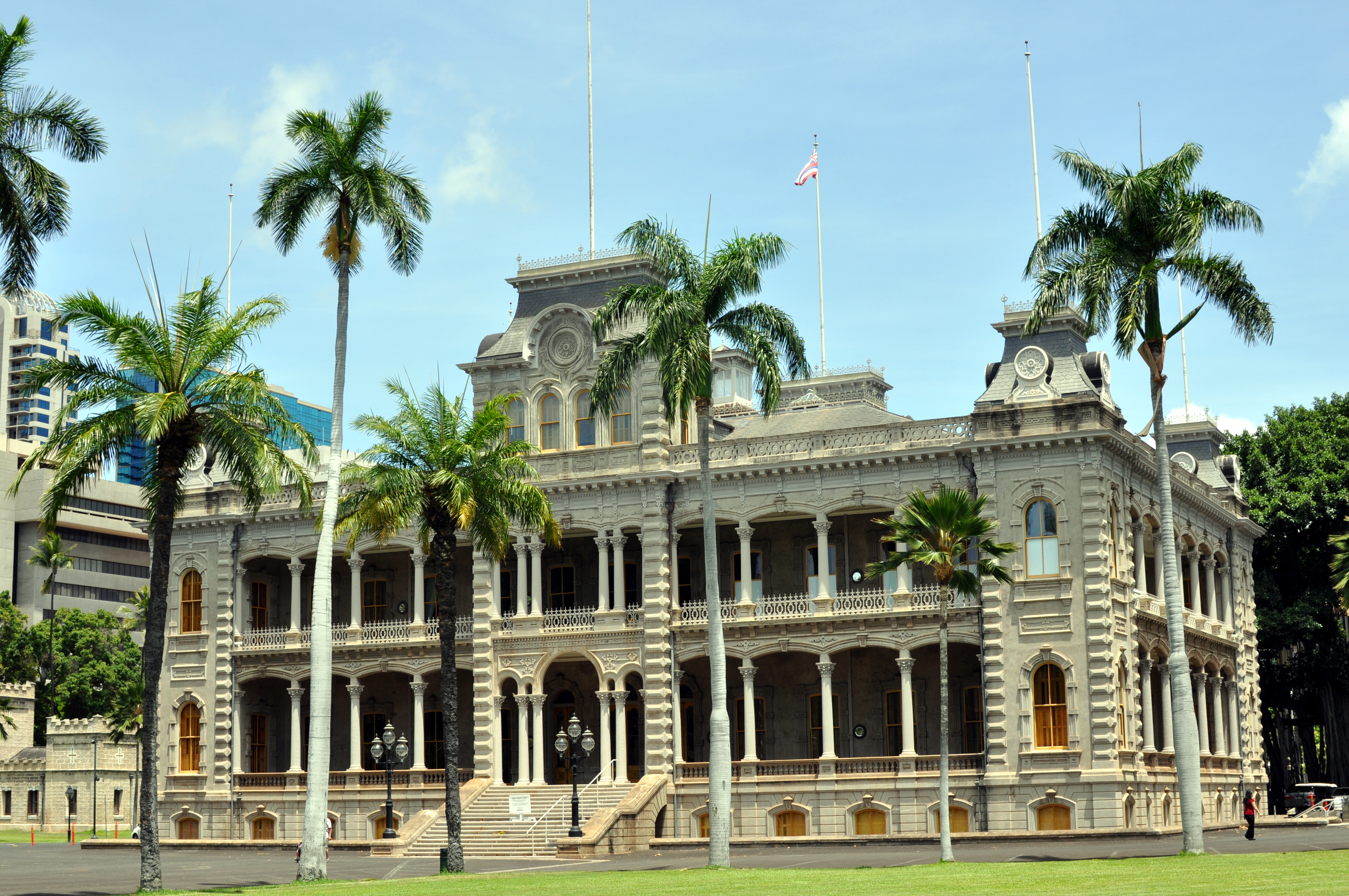:max_bytes(150000):strip_icc()/the-iolani-palace-96622058-5aaa7f168e1b6e0037aed323.jpg)
The Last Crown: ‘Iolani Palace and the Enduring Spirit of Hawaiʻi
Amidst the modern skyscrapers and bustling thoroughfares of downtown Honolulu stands a silent sentinel, a magnificent edifice of stone and grandeur that whispers tales of a bygone era. ‘Iolani Palace, the only official royal residence in the United States, is more than just a historical building; it is the enduring heart of a lost kingdom, a monument to the resilience of a people, and a poignant reminder of a sovereignty tragically curtailed. Its very presence on the island of Oʻahu is a profound historical anomaly, beckoning visitors to step through its stately doors and journey into the dramatic saga of the Hawaiian monarchy.
Constructed in 1882 for King Kalākaua, ‘Iolani Palace was a bold declaration of Hawaiʻi’s place on the world stage. Kalākaua, known as the "Merrie Monarch" for his love of music, dance, and cultural revival, envisioned a palace that would rival those of Europe, a symbol of his kingdom’s modernity and independence. And indeed, it was a marvel of its time. Designed in the American Florentine style, a unique blend of Italian Renaissance and local volcanic stone, its architecture was both imposing and elegant. The palace boasted four corner towers, a grand lanai, and an ornate iron fence, all contributing to an aura of sophisticated power.
Yet, it was not merely aesthetic appeal that set ‘Iolani Palace apart. Kalākaua ensured his royal residence was equipped with state-of-the-art amenities, making it a beacon of progress. ‘Iolani Palace had electric lights installed in 1886, a full four years before the White House, and a cutting-edge telephone system connected the monarch to his ministers. Running water and flush toilets were also considered luxuries that spoke to Hawaiʻi’s forward-thinking approach. This was not a remote, unsophisticated island nation; it was a sovereign kingdom engaging with the world, a point of pride for Kalākaua who famously embarked on a world tour, becoming the first reigning monarch to circumnavigate the globe. His aim was clear: to secure Hawaiʻi’s independence and foster alliances, asserting its legitimacy among global powers.

The interior of the palace was equally impressive, reflecting the tastes and aspirations of the monarchy. The Throne Room, a vast space adorned with crimson and gold, was where foreign dignitaries were received, and state balls captivated the Hawaiian elite. Here, the King and later his sister, Queen Liliʻuokalani, presided over their court, their thrones serving as the literal seats of power. The State Dining Room, the Blue Room, and the King’s and Queen’s private apartments were meticulously furnished with custom-made pieces, many imported from Europe and Asia, alongside traditional Hawaiian crafts, creating a unique fusion of global influence and local identity. Portraits of Hawaiian monarchs gazed down from the walls, silent witnesses to the unfolding drama of their lineage.
However, the grandeur of ‘Iolani Palace would ultimately serve as a stark contrast to the tragic events that unfolded within its walls. The late 19th century was a tumultuous period for Hawaiʻi. Foreign business interests, particularly American sugar planters, exerted increasing political pressure, seeking annexation to the United States for economic advantage. King Kalākaua, despite his efforts to maintain sovereignty, was forced to sign the Bayonet Constitution in 1887, a document that significantly curtailed his powers and disenfranchised many Native Hawaiians. He died in San Francisco in 1891, a broken man, succeeded by his sister, Liliʻuokalani.
Queen Liliʻuokalani, a gifted musician and composer whose melodies still resonate through Hawaiian culture, ascended the throne with a deep commitment to her people and their independence. She understood the growing threats to Hawaiian sovereignty and immediately sought to restore power to the monarchy and Native Hawaiians by promulgating a new constitution. This act, however, was perceived as a direct challenge by the foreign-backed "Committee of Safety," a group of American and European businessmen and residents.
On January 17, 1893, with the tacit support of U.S. Minister John L. Stevens and the presence of U.S. Marines ostensibly there to protect American lives and property, the Committee of Safety orchestrated a bloodless coup. Queen Liliʻuokalani, faced with the prospect of bloodshed if she resisted, chose to surrender under protest. From the very steps of ‘Iolani Palace, she issued a statement: "I yield my authority until such time as the Government of the United States shall, upon the facts being presented to it, undo the action of its representatives and reinstate me in the authority which I claim as the constitutional sovereign of the Hawaiian Islands." It was a plea to a higher power, a hope that justice would prevail, but one that would ultimately go unanswered.
The palace, once a symbol of her power, became her prison. Following an alleged counter-revolution in 1895, Queen Liliʻuokalani was arrested and confined to a single bedroom on the second floor of ‘Iolani Palace for nearly eight months. The very place where she had hosted lavish balls and made critical decisions of state became her gilded cage. During this period of profound isolation and sorrow, she found solace in her music and writing. It was here that she penned her famous protest, ʻŌlani, a mournful song reflecting on her palace and her lost kingdom, and began translating the Kumulipo, the Hawaiian creation chant, into English, an act of cultural preservation against the tide of foreign dominance. She also crafted a beautiful quilt, its patterns imbued with symbols of her ordeal and her enduring love for Hawaiʻi, a poignant testament to her spirit.
The monarchy was abolished, and Hawaiʻi was annexed by the United States in 1898. ‘Iolani Palace then underwent a transformation, becoming the executive building for the Territory of Hawaiʻi, and later, the State Capitol. The royal emblems were removed, the Throne Room was converted into legislative chambers, and the grand residence adapted to bureaucratic functions. For decades, the palace served this utilitarian role, its royal past gradually fading in the public consciousness, its once vibrant interiors showing the wear and tear of administrative use.
However, the spirit of ‘Iolani Palace was not extinguished. In the mid-20th century, a growing movement for Hawaiian cultural preservation and a renewed interest in the monarchy’s history led to calls for the restoration of the palace. The Friends of ‘Iolani Palace, a dedicated non-profit organization, was established in 1966 with the monumental task of returning the palace to its 1890s glory. This was no small feat. It involved decades of painstaking research, fundraising, and the meticulous recovery of original furnishings, some of which had been sold off or scattered across the globe.
Today, ‘Iolani Palace stands as a triumph of historical restoration. Visitors can walk through the re-created Throne Room, imagining the pomp and ceremony of a bygone era. They can explore the State Dining Room, where kings and queens entertained, and ascend the grand koa wood staircase, just as the monarchs once did. The private apartments, including Queen Liliʻuokalani’s imprisonment room, evoke a deep sense of empathy and reflection. Every detail, from the patterns on the wallpaper to the fabrics of the upholstery, has been carefully researched to ensure historical accuracy, offering an authentic glimpse into the lives of Hawaiʻi’s last monarchs.

More than just a museum, ‘Iolani Palace is a living classroom and a powerful symbol of Hawaiian identity. It serves as a vital educational resource, teaching both locals and visitors about a crucial period in Hawaiʻi’s history that is often overlooked in mainstream narratives. It is a place of remembrance, where the sacrifices and struggles of the Hawaiian people are honored. For many Native Hawaiians, the palace is a touchstone of their heritage, a site of spiritual significance and a potent reminder of their enduring cultural legacy and the ongoing quest for self-determination.
As the sun sets over Honolulu, casting long shadows across its elegant façade, ‘Iolani Palace remains. It is a testament to the vision of a king, the courage of a queen, and the resilience of a people. Its walls have witnessed both the pinnacle of power and the depths of despair, the vibrant pulse of a thriving kingdom, and the quiet sorrow of its overthrow. To walk through its hallowed halls is to confront a complex history, to understand the beauty of Hawaiian culture, and to feel the lingering echoes of a royal past that, though lost, continues to inspire and inform the present and future of Hawaiʻi. It is a crown jewel, not just of architecture, but of the human spirit, forever whispering the story of the last crown.


